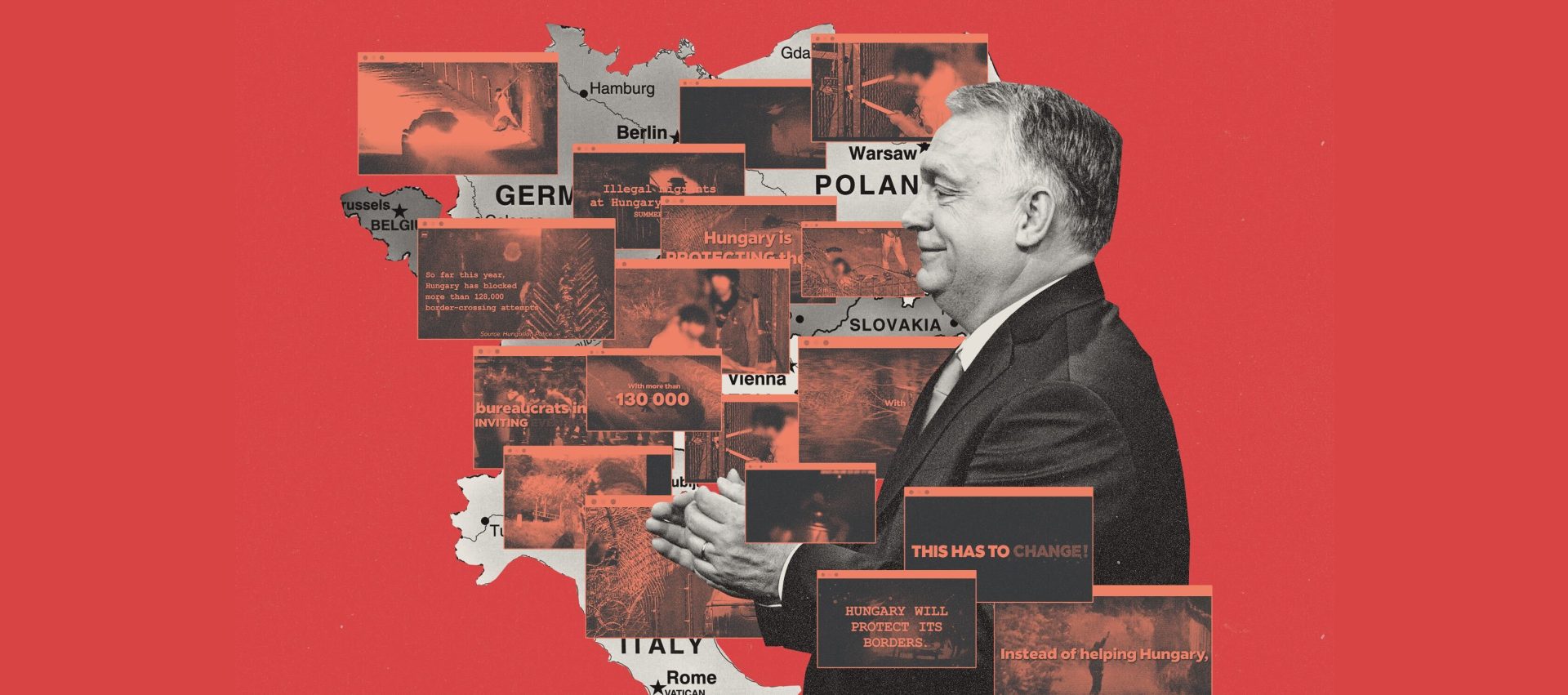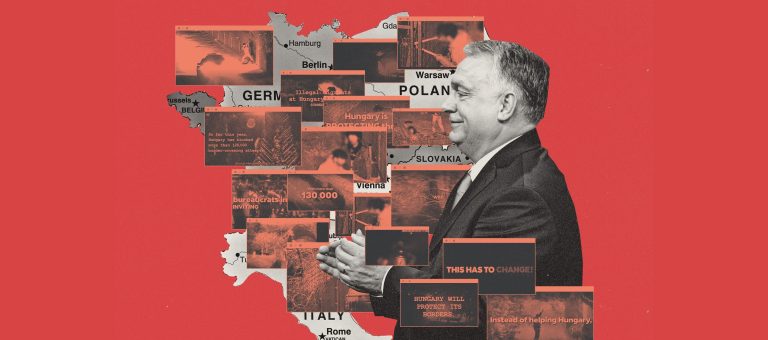Cover by Péter Somogyi (szarvas)/Telex 2024-02-29
Cover by Péter Somogyi (szarvas)/Telex 2024-02-29
At one point in his 2024 State of the Nation address, Prime Minister Viktor Orbán said that “we cannot interfere in other countries’ elections, but we would very much like to see President Donald Trump return to the White House.” The Hungarian government’s stance on election interference has long been characterized by this tension: they talk about Hungary not interfering in other countries’ internal affairs – and state their expectation that others not interfere in Hungary’s – while at the same time regularly advocating for the re-election of foreign allies, from Trump to Jair Bolsonaro of Brazil.
However, there are signs that the Hungarian government is trying to shape public discourse in foreign countries not only through statements, but also through Hungarian state resources and taxpayers’ money — and, in many cases, even doing so during ongoing election campaigns.
In the autumn of 2023, the Hungarian Prime Minister’s Cabinet Office ran video campaigns on YouTube on the dangers of illegal migration in seven EU countries. These ads appeared on users’ screens a total of 8.35-9.7 million times, VSquare.org and Direkt36 found by analyzing Google’s online advertising transparency database. In two of the seven countries – Slovakia and Poland – the ads started appearing in the run-up to parliamentary elections, while in two others – Germany and Italy – the ads ran when provincial and local elections were taking place. The ministry in charge of these campaigns – and government propaganda in general – is led by Minister Antal Rogán.
In terms of views relative to population, the campaign was most intense in Slovakia, where between 1.6 million and 1.8 million video ads online could theoretically have reached between 29 and 33 percent of the population (the same ad can also appear more than once for the same user, according to Google’s database). These online advertisements could have reached internet users who are on YouTube and have not turned off ads, and who had been targeted by the Hungarian government on the basis of age, geography, interests, etc.
According to one expert with international experience in online political advertising campaigns, savvy advertisers set their ads to appear 5-7 times per user because that’s how many views it takes for advertising to be effective.
Both advertisements are in English, but while one of them offers via voiceover that “Hungary protects the EU from illegal migration,” in the other one, English subtitles accompany shots of the Hungary-Serbia border fence, partly filmed with night vision cameras, and tense music. The footage shows, among other things, the border fence being dismantled and the authorities protecting it being attacked from the other side of the fence. The advertisements thus formally promote the Hungarian government’s anti-migrant measures. At the same time, they also stress the dangers of migration and the violence of migrants.
These advertisements also appeared in countries when allies of the Orbán government, also campaigning with anti-migrant slogans, were competing in parliamentary or local elections.These ads aired in the late summer-early autumn of 2023, when the migration crisis in southern Slovakia was at its peak, with tens of thousands of people from the Middle East managing to make their way to Slovakia and even southern Poland — despite allegedly strict Hungarian border protection. In response, countries in the region from Austria to Poland introduced temporary border controls.
Hungarian advertisements have attracted the attention of Slovak politicians. “As a government, and personally as the Minister of Defense, I have been informed about the Hungarian government’s interference in Slovakia’s electoral system and processes. This includes deliberately highlighting issues like migration, which was a top priority,” said Jaroslav Naď, Slovak defense minister between 2020 and May 2023, in a conversation with our Slovak partner, the Investigative Center of Ján Kuciak (ICJK.sk). Regarding these Hungarian online advertisements, Naď expressed his belief that the Orbán government was supporting the anti-immigration Smer party, led by old-new Slovak Prime Minister Robert Fico. (Naď, as a member of the then-governing OľaNO party and later as the leader of the Democrats party, is a political adversary of Fico.)
Poland’s Tygodnik Powszechny, the Hungarian edition of Radio Free Europe and the Czech news site E15 have separately reported that the Hungarian prime minister’s office’s advertisements have appeared in Poland, Slovakia and the Czech Republic, but the number of ads has not been known until now, as Google – which owns YouTube – only publishes details three months after an advertising campaign ends. It was also not known until now that the Hungarian government also advertised in Austria, Germany, Italy and Belgium, or that the ads ran simultaneously in five to seven European countries.
Neither the Hungarian Prime Minister’s Cabinet Office nor Google responded to our requests for comment.
“If you know the rules of the ads platform, this is how you can get around it”
Orbán’s Cabinet Office’s first video advertisement ran between September 28 and October 11 2023. The second ran from October 10 to 24, 2023 in the seven countries (but only the second of the two videos ran in Belgium). Google distinguishes between two types of advertising: political and non-political. The former is subject to stricter transparency rules. For example, the US company also discloses some basic information on what types of users advertisers target with political ads and how much money they have spent on them. However, the Hungarian government ran these videos as non-political ads, as they were not technically advertising a political party in Hungary or during domestic election campaigns. The transparency of non-political advertisements is significantly more limited.
This also means that Google’s advertising transparency database only reveals the start and end time when the ads ran and the approximate number of times that Hungarian state-sponsored advertisements appeared. There is no public information on the target audience or on the amount spent on advertising. When previously contacted by Czech news site E15, Google confirmed that the relevant Hungarian government ads do not violate the terms of use and, as they do not promote political parties or politicians, are not political ads.
“Google is remarkably lenient in its classification of what constitutes political advertising. Based on my experience, approximately 80 percent of advertisements deemed non-political by Google are identified and rejected as political by Facebook’s automated software check,” one expert in online political advertising campaigns with international experience, who wished to remain anonymous, told us. “Being categorized as a political ad on Google restricts your audience targeting options significantly, but Hungarian government ads running in foreign countries, not qualifying as political, allowed advertisers much broader targeting capabilities,” the expert noted.
The European Union has recently stepped up its regulation of social media platforms and their use of user data for advertising. Current EU regulations prohibit Meta (Facebook), Google and other platforms from the previous practice of essentially freely sharing users’ personal data with advertisers, particularly in the case of possible use for political ads. “Nevertheless, by understanding the internal rules of these ads platforms, you can get around them to access a broader set of tools by attempting to register your advertisement as non-political,” the expert on online campaigning added. In the context of the Slovak elections, this strategy enabled the Hungarian government to define its target audience for officially non-political ads with much more precision than Slovak political parties, which were restricted to running ads explicitly labeled as political.
The exact number of times the Hungarian government ads appeared is not publicly available. We only know the range of views, from the minimum and maximum possible times people saw it. At the same time, the number of views of the advertised videos on YouTube also does not reflect the number of times the videos have appeared to users via ads: According to Google/Youtube advertising rules, an advertised display of a video only counts as a full view – i.e. it only increases the number of views below a video on Youtube – if the user watches a short-duration video (that is, a video that is less than 30 seconds long) until the end, or a longer duration video (which is longer than 30 seconds) for at least 30 seconds.
Of the two Hungarian government videos advertised abroad, the first – which was aired before the Slovak elections and has no narration, only subtitles – is 37 seconds long and has 1.1 million views on Youtube, which means that it has been watched for at least 30 seconds this 1.1 million times. The second video, which is 14 seconds long and has narration, has only 7600 views, which is the number of viewers who watched it from start to finish. It is also not disclosed how many viewers from which countries arrived at the two advertised videos.
However, there’s a more critical metric than the sheer volume of advertisements: “The key lies in ad frequency, or how many times an individual is exposed to the same advertisement,” the online political campaign expert told.
“The traditional benchmark within the industry is seven — that is, an advertisement needs to reach an individual seven times to be effective. In other words, it’s more impactful for a quarter of a million people to encounter an advertisement four times than for a million people to see it just once. Professional advertisers, like the Hungarian government, typically aim for an ad frequency between five to seven,” the source explained. Additionally, the specific frequency at which the Hungarian government’s advertisements were broadcasted is not disclosed. “Such details are not made available in any advertising library [a public database of advertisements],” the expert added.
How much the Hungarian government spent on these foreign advertisements is also unclear. Following initial reports about the Hungarian government’s foreign ads in the Polish election campaign, Hungarian independent MP Ákos Hadházy attempted to obtain information through a public information request. However, the PM’s Cabinet Office avoided giving a direct answer, claiming that they do not keep a record of the advertisements in question. “The cost of advertising depends on more than just the number of impressions, or views; several other factors play a role. Market saturation, for example, or how many advertisers are competing for attention at the same time, can drive up prices, similar to the stock market. This is especially true during campaign periods when many are vying for visibility,” the online political campaign expert said. Additionally, according to the expert, the price of advertisements is significantly influenced by how precisely an advertiser defines its target audience.
According to Google’s advertising database, Slovak political campaign videos that were similar in impressions to the two Hungarian videos cost between €2,000 and €15,000 (currently equivalent to approximately 790,000 to 5.9 million HUF). However, this may not necessarily be indicative, as the target audience for the Hungarian “non-political” advertisements could be specified in much greater detail, potentially significantly increasing the cost of advertising.
“Hungary played an intensive role in Fico winning the elections”
Parliamentary elections were held in Slovakia on September 30, at which point the Orbán government used other means – such as an interview with Robert Fico broadcast on Hungarian public media during right before the election, when all Slovak campaigns were meant to be silent – to support the campaign of the old-new Slovak prime minister, a close ally of Viktor Orbán. Fico’s victory was of particular interest to Orbán’s party, as they counted on the populist-leftist Slovak prime minister’s help both to revive regional cooperation in the Visegrad Group and to block the so-called Article 7 procedure against Hungary in Brussels. Robert Fico and his far left-wing and nationalist allies, who campaigned with pro-Russian and anti-Ukrainian slogans, like Orbán’s government, eventually won the election.
Google’s database shows that on September 28, two days before the Slovak election and thus during the campaign blackout period under Slovak law, the Hungarian government started running YouTube ads, the first of which was seen 900,000 to 1 million times. The second, which ran after the election, was seen somewhere between 700,000 and 800,000 times. The combined number of impressions of the two ads is roughly one third of the population of Slovakia. It is not possible to say from the public details of Google’s database to what extent views of the first ad were concentrated in the days before the Slovak parliamentary elections (the ad continued after the election, so some of the views may well have been after the votes were cast).
“I was surprised by this number. It was indeed a very intensive advertisement targeting Slovakia on the issue of migration. I see no other reason for this than the Hungarian government’s interest in helping to raise the issue,” said former Slovak defense minister Jaroslav Naď to ICJK.sk regarding the Hungarian government advertisements. “And of course, you’ve seen how Smer [the party of current Prime Minister Robert Fico] constantly stoked up fear against migrants, so this [ad] fits perfectly into the debate,” the former minister added.
“If I wanted to influence public opinion in this way, especially just a day or two before the Slovak elections, I would do the same,” Naď stated, emphasizing that “this kind of behavior is wrong and unacceptable. When we ran campaigns, we always targeted the citizens of Slovakia, communicating with our own citizens, not those of other countries.” According to the former defense minister, “Hungary indeed played a very intensive role in Robert Fico winning the elections.”
By comparison, according to Google’s advertising database, more intensively advertised videos put out by Slovak political campaigns had somewhere between 1 and 2 million impressions, with the most viewed video advertisement belonging to Slovakia’s right-wing liberal Freedom and Solidarity party (that video made more than 10 million impressions). However, these videos were all run throughout the campaign – and before the period of campaign silence – and thus competed with each other, while the Hungarian government’s video ad, labeled as non-political, was launched just as the campaign silence period began.
Poland elected a new government on October 15. Another Orban ally, the populist right-wing Law and Justice party, in power since 2015, was favored to win — but a coalition of center-right, centrist and left-wing parties won the election, which produced record turnout. In Poland, between the end of September and mid-October, Hungarian government advertisements made a total of between one and a half and two million Hungarian government impressions, a number that is the equivalent of 4 or 5 percent of the Polish population.
It is not possible to say, partly because of Google’s limited information disclosure, which regions, cities and voter groups these ads targeted – nor do we know exactly what role, if any, they played in the outcome of the two countries’ elections.
One role they played for sure, though, was that of a contribution to the public discourse. “This campaign is an example of how a united front of right-wing parties operates in Europe, using migrants and refugees as a bogeyman designed to heat up negative emotions. In these videos we see a one-sided portrayal of migrants as dangerous people,” said Łukasz Jakubowski from Nigdy Więcej (Never Again Association), a Polish NGO that monitors and fights against hate speech. “Using such a narrative in election campaigns leads to acts of violence against foreigners and minorities, because its recipients see a threat in people of a different skin color,” Jakubowski added.
The Orbán government’s involvement in the Slovak and Polish election campaigns was not limited to video advertisements. As we previously revealed in VSquare’s newsletter, key Orbán campaign strategist Árpád Habony and Hungarian government-linked advisory firm Századvég, including foreign affairs director Csaba Faragó, actively helped the campaigns of Orbán’s local allies in Central Europe. In Slovakia, this initially meant the center-left HLAS party, led by former prime minister Peter Pellegrini’s, and then Robert Fico’s Smer, while in Poland, it was the Law and Justice party. After Hungary’s Polish allies lost the election, Polish weekly Polityka reported that many in Law and Justice blamed the defeat on unnamed Hungarian campaign advisors (these Hungarians were not named at the time).
While there were no elections in Austria, the Czech Republic or Belgium at the time of the ads, there were local elections in Germany and Italy. On October 8, both the right and the far-right gained strength in the German states of Bavaria and Hessen, thanks in part to the fact that migration was a major issue in German campaigns. It is not known, however, in which provinces or cities the Prime Minister Cabinet Office’s advertisements were focused. In Italy, elections were held on October 22 in the autonomous region of northern Italy, centered on Trento, and were won by the candidate of the far-right Lega party, led by Orbán ally Matteo Salvini. Here, too, there is no information on exactly which areas of Italy the Hungarian advertisements targeted.
To date, the most significant known case of Hungarian government involvement in a foreign election was during the 2022 French presidential elections. Back then, the Hungarian MKB Bank financed far-right presidential candidate Marine Le Pen’s campaign with €10.6 million. As the Financial Times revealed, the request for MKB to support the French politician came from Viktor Orbán’s inner circle.
Karin Kőváry Sólymos (Investigative Center of Ján Kuciak) and Daniel Flis (Frontstory.pl) contributed to this article.
Subscribe to Goulash, our original VSquare newsletter that delivers the best investigative journalism from Central Europe straight to your inbox!
VSquare’s Budapest-based lead investigative editor in charge of Central European investigations, Szabolcs Panyi is also a Hungarian investigative journalist at Direkt36. He covers national security, foreign policy, and Russian and Chinese influence. He was a European Press Prize finalist in 2018 and 2021.







